
Page 2 of 5
Wolves in the Lamar Valley
Early the next morning, when we left the lodge at Mammoth Hot Springs in the cold dark before dawn, we drove through snow-covered mountains that slowly grew light as the sun came up, and entered the wide meadows, low hills and ridges of the remote Lamar Valley, which more than lived up to its reputation as perhaps the best place in Yellowstone to see wildlife.
It was a beautiful day, clear with a huge, intense-blue sky, and very cold. The landscape was open to great distances, the Absaroka Mountains to the north, and dark gray creeks riffling through the valley. Herds of bison and small groups of elk were scattered across the meadows and on the hillsides. A coyote traveled alone through deep snow across a slope.
Our van came to a stop behind five or six others, at a spot where several watchers already had set up tripods, scopes and cameras. The wolves were a long way away, barely more than dark dots standing or moving around on a snow-covered slope mottled with rocks. At first it was hard to see them at all, but gradually, the more I watched, the more clear they became, emerging from the background. I watched them through binoculars and took turns with others looking through scopes, finding two gray wolves, then a third, a fourth, a fifth, and more, most gray, but some were black. They didn’t seem to be doing much. Standing. Moving one way, then another. It was the well-known and much-observed Druid pack of the Lamar Valley. Before we arrived they had been feeding on an elk carcass near the top of the ridge. A group of several elk grazed in the near distance.
After a while, two of the wolves, one gray, one black, began to climb slowly and steadily up a crease in the hillside, making their way through chest-deep snow. Very gradually the other wolves followed them in single file, walking in the trough the first two had begun. Six, seven, twelve, fourteen, maybe fifteen wolves all trekked up the ridge in epic slow motion, until finally the first two reached the top of the ridge and emerged from the background of white to stand outlined together against the sky. “That’s the alpha male and alpha female,” Betsy said.
My hands and feet by this time were so cold they hurt, but I think I would have stood there watching all day, or as long as the wolves were in sight. I had hoped we would see them – that was why we were there, of course – but I had been completely unprepared for how it would feel. Even though they were so far away, it was stunning.
We returned to the vans – where I inserted hand warmers into my gloves and foot warmers beneath the frozen toes in my boots, something I should have worn to begin with, and was never without after this frigid morning – and drove slowly on, gradually thawing, through the big, open, snow-covered valley. Elk were scattered here and there, mostly cows and calves and a few males with small spike horns, some grazing, others curled up on the snow.
Bison and American Magpies
If there was one animal emblematic of our visit to Yellowstone in winter, it was the bison. We found them almost everywhere, often very close. In the Lamar Valley, we passed many groups of bison, sometimes standing, sometimes bedded down in the snow and sun, their heavy brown fur thickly crusted in snow over the back and head.
Because they often use the roads, where walking is easier than breaking new paths, we often saw bison at very close range as one or more passed by our vehicle. When this occurred, the vans slowed to a cautious crawl or stopped until they passed. I watched through a window as one massive, shaggy brown head moved by, a small dark eye almost buried in the fur, the curved, neat horns and large hump, the big head down and swinging from side to side, moving slowly, though they can move very fast at times. It was an animal of immense dignity, despite being the focus of so much rude observation – including my own.
We stopped to watch one group of several cows and two calves walking along the roadside. One large cow was in the lead, breaking the trail, using the muscles in her hump to swing her head from side to side and clear the snow. The others followed her in a straight, single-file line, making a perfect 90-degree turn toward the road and up and across it.
Another time we stopped to watch a small group of bachelor males in a meadow not far away. Two of the young males were butting heads over and over again, in an easy, restrained way, going through the motions but not seriously threatening. Two American magpies – striking black birds about the size of a blue jay with white belly and large white patches in the wings and often flamboyant behavior – flew in and each sat briefly on the snow-crusted rump of a bison – which didn’t seem to mind. I later learned that the magpies often find food by gleaning ticks and other parasites from ungulates like deer, moose and bison. But I couldn’t help but wonder if, in this case, the magpies also might have found a bison’s rump a nice warm spot on a very cold day.
American Dippers
As we drove through the valley, following a dark blue-gray stream that looped between low banks of snow and might have been Soda Butte Creek – I’m not sure – we saw the first American dippers – small, charcoal-gray birds that looked almost black with rather large, round heads and short tails. The first one I saw was only a round gleaming head bobbing in and out of the water, just popping quickly up and back down again. Then a little further along we saw one quite clearly, out of the water, and after that passed several more. They were very active and quick-moving, never still, sometimes flying low over the stream or wading or hopping from rock to rock in the stream.
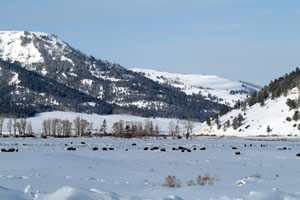
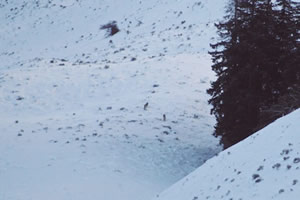
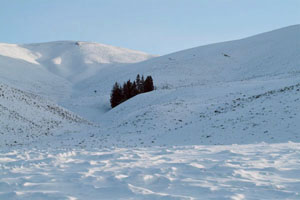
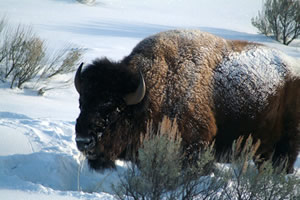
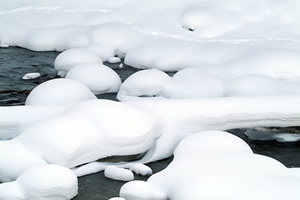
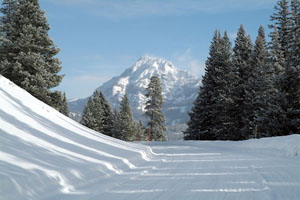
Copyright © 2009 Sigrid Sanders| All Rights Reserved